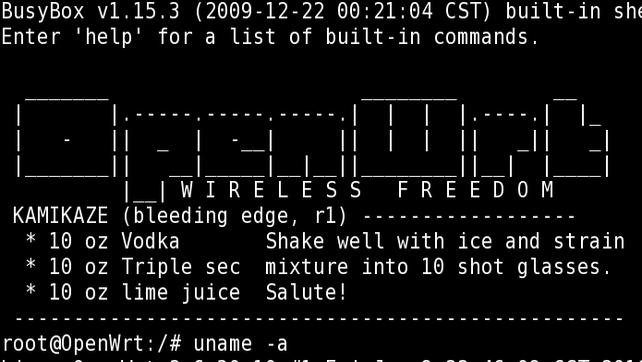Install Tinyproxy Openwrt
Dynamic Updates in the Domain Name System - DNS UpdateThough, Dynamic DNS as specified in RFC 2136(is not directly what is used by the broadproviders of custom DNS updates. Today they often provide a HTTP REST likeinterface to push credentials, updated domain name and IP addresses. Theprovider then update the corresponding DNS entries.


The 'real' Dynamic DNSupdate mechanism works by providing an inband mechanism to update the DNSdatabase by using a special DNS record. The mechanism is more complex, requiredDNS tooling and most important a cryptographic secured infrastructure.
It”ssomehow understandable that DynDNS providers bypass this and use some lightermechanism to update the database.There are many providers in the market offers DynDNS services. Probably youalready have one. I use since severalyears (not only as DNS Update service) and feeling quite fine. The guys fromHurricane Electric (HE) are professional, know what the crowd wants and do aperfect job! The next paragraphs describes the setup procedure for HE andassumes you already have a domain name and want to use them by simpledelegating a sub domain to HE.Imagine yourisnamed FooBar and you already registered example.com there. Example domain isyou primary and only domain: you operate HTTP, SMTP, IMAP and other servers bythis host.
Hi all, Im a completely newbie using Gargoyle and OpenWRT. I have a few questions for the experts that have patience and time. I have an external HD (2 Tb) connected in my TL-WR1043ND on USB port, with ext4, and works like a charm. Flash existing Access Point s with the OpenWrt Kamikaze 7.06 software, and acquire replacements for those Access Point s which can not be flashed with OpenWrt. Install ChilliSpot on each Access Point running OpenWrt to act as a gatekeeper. Install TinyProxy on each Access Point running OpenWrt to act as a transparent proxy. Greetings, I just finished installing openwrt on my linksys WRT1900 ACS. Openwrt is working Ok but I am having issues with my tinyproxy.
But you want to use this domain also to access your home network.The way to go is to add another subdomain and change the DNS responsibilitiesfor this subdomain. Let’s name the subdomain ‘home’, resulting in a FQDNhome.example.com. Next, transfer the nameserver authority for this domain toHE. In DNS speech: add a NS record for home.example.com and point it to HE.This is normally done in a web based administration panel from your registrar(FooBar). After the change you should see the modifications in the DNSdatabase: dig @8.8.8.8 +short home.example.com NSns4.he.net.ns3.he.net.ns1.he.net.ns2.he.net.ns5.he.net.Next step is to let HE know that the sub-domain is now managed by HE. The HEDNS administration desk provides all knobs to do that.
Openwrt Privoxy
I don’t want to go intothe details because the configuration is quite simple. You can add newsubdomains like router (FQDM: router.home.example.com) and choose between astatic mapping or a dynamic one for IPv4 (A record) and IPv6 (AAAA record).Because I have a permanent IPv6 address I add the IPv6 address directly here.No need to change this dynamically via DNS update. For IPv4 you need togenerate a dynamic DNS key. This key is later used to change the IPv4 addressand prevent other bad guys to change the address and point to some other hosts.For now, just remember your username and the newly created password.Now install the required OpenWrt software: opkg updateopkg install ddns-scriptsNow we overwrite the default configuration in /etc/config/ddns with your newdata. Config service 'heipv4'option enabled '1'option servicename 'he.net'option domain 'router.home.example.com'option username 'USERNAME'option password 'PASSWORD'option interface 'wan'option ipsource 'network'option ipnetwork 'wan'Simple start the local DDNS service, enable the service permanently and to makesure everything is working you should trigger a interface up signal with thereason that the DDNS service detects the current IP address. Alternatively,Windows style: you can reboot your router.
/etc/init.d/ddns start/etc/init.d/ddns enableACTION =ifup INTERFACE =wan /sbin/hotplug-call ifaceNow check that everything is working. Query the AAAA and A record for yourdomain. For IPv6 you should see the static address and for IPv4 you should seethe ISP provided IPv4 address. Afterwards you can use a online ping service toverify connectivity. OpenWrt’s default firewall rules let ICMPv4 and ICMPv6 in(with some rate limiting restrictions). Dig @8.8.8.8 router.home.example.com AAAAdig @8.8.8.8 router.home.example.com A Guest WiFi and FreifunkMany OpenWrt configurations show how to setup a Guest WiFi. Normally areduced feature set WiFi, e.g.

Install Tinyproxy Openwrt Windows 7
Firewalled with exception of HTTP and HTTPS.The guest WiFi is often VLAN tagged to make sure that unsecure and secure datado not use the same network.I don”t provide an guest network and I do not restrict guest. Rather I host anode for the neighborhood which can beused by guests too.
The additional Freifunk router (costs 20 euro) use his ownfirmware (right, a own modified Openwrt version with BATMAN routing, Fastd,etc. All traffic from this router is tunneled via VPN to a another routerin Munich. So I can’t even see what the guests do! The only limition for guestsis a slight up- and downlink shapping. Just to make sure that guests do notsaturate my ISP link - thats all.If you want to participate you can join the monthly here in Munich or in yourtown. Meet great people, talk about OpenWrt and allow people to download theirfavorite cat images.